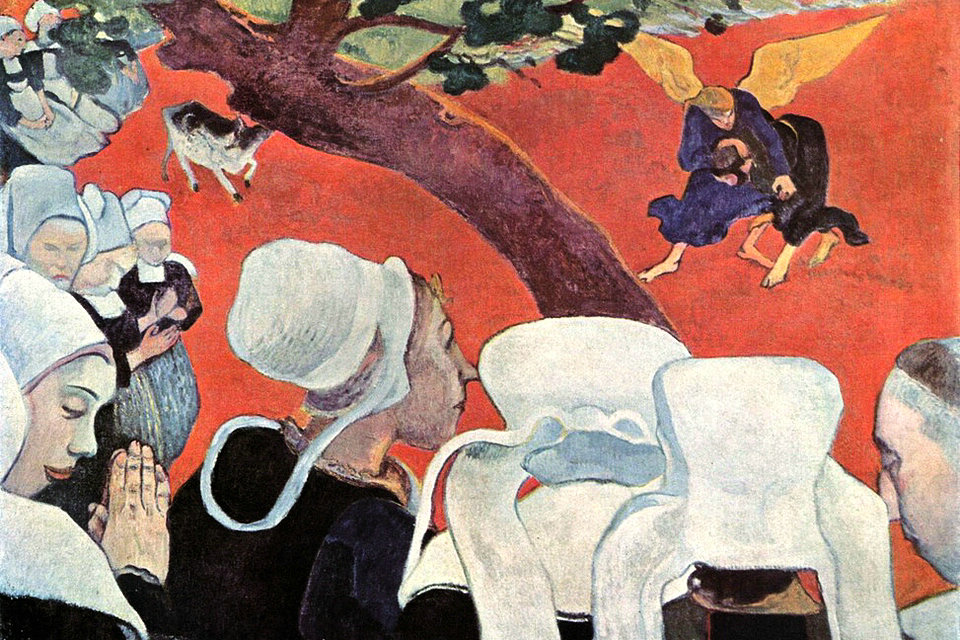

Cloisonnism is a style of post-Impressionist painting with bold and flat forms separated by dark contours. The term was coined by critic Edouard Dujardin on the occasion of the Salon des Indépendants, in March 1888. Artists Émile Bernard, Louis Anquetin, Paul Gauguin, Paul Sérusier, and others started painting in this style in the late 19th century. The name evokes the technique of cloisonné, where wires (cloisons or “compartments”) are soldered to the body of the piece, filled with powdered glass, and then fired. Many of the same painters also described their works as Synthetism, a closely related movement.
Cloisonnisme is a pictorial technique that consists of encompassing chromatic plaques within the net boundary of a contour, with no chiaroscuro effects, thus creating compact color shapes its formal quality and its paintings have no depth or shadows It needs some decorative effect.
The term was coined by the French art critic Édouard Dujardin and was first used by him in an article published on May 9, 1888 in the Revue Indépendante. Dujardin referred to the paintings by the French painter Louis Anquetin that had recently been shown in an exhibition by the Belgian artist group Les XX ( Les Vingt ) in Brussels.
The origin of cloisonism can be traced back to the considerations and experiments to which Louis Anquetin and Émile Bernard devoted themselves in response to neo-impressionism in 1888. Both turned away from the divisionism they had previously experimented with and developed new strategies together. They found their inspiration, among other things, in Japanese engravings (see Japonism ).
The term, used for the first time by the art critic Édouard Dujardin, evokes the technique, dating back to the Middle Ages, of building windows where the contours of the figures form compartments (cloisons) which surround the individual pieces of colored glass; a similar effect is obtained with the technique of enamel on metal, where each color is reserved a space that is filled with glass powder, the product is then subjected to high temperatures that melt the glass, forming compact and free colors of chiaroscuro effects. Dujardin wrote that
“These paintings give the impression of a decorative painting, an external layout, a violent and jet color inevitably recall the imageries and the Japaneseries. Then, under the hieratic tone of drawing and color, one senses a surprising truth that frees itself from the romanticism of passion, and above all, little by little, our analysis is recalled on the intentional, rational, intellectual and systematic construction […] the painter will trace the design with closed lines within which he will place different tones, the overlapping of which will give the sensation of the general color sought, since color and design interpenetrate each other. The work of this painter is something like a cloisonné- like compartment painting, and his technique will be a kind of cloisonnisme ”
Characteristics of cloisonism are the rejection of the central perspective, the reduction of the image content to its elementary forms, the extensive application of mostly saturated colors and, in particular, the strong contouring of the surfaces, which inspired Édouard Dujardin to create his words. This referred to the corresponding works as quelque chose comme une peinture par «compartiments», analogue au cloisonné, (German: something like a painting from «departments», analogous to the cloisonné technique ), which is why often for the explanation of cloisonism attention is drawn to the technique of cell melting (cloisonné), in which the colored areas are in enamel work be delimited by metal bars.
Bernard and Anquetin’s achievements were soon taken up by Paul Gauguin and used in synthetics. Other artists inspired by cloisonism were Paul Sérusier and various Nabis, including Henri Matisse, and representatives of Expressionism.
In The Yellow Christ (1889), often cited as a quintessential cloisonnist work, Gauguin reduced the image to areas of single colors separated by heavy black outlines. In such works he paid little attention to classical perspective and boldly eliminated subtle gradations of color—two of the most characteristic principles of post-Renaissance painting.
The cloisonnist separation of colors reflects an appreciation for discontinuity that is characteristic of Modernism.
Other Works
Émile Bernard Self-portrait with portrait of Gauguin, dedicated to Vincent van Gogh. Bernard, 1888
Émile Bernard, Breton Women in the Meadow, August 1888. Bernard exchanged this one with Gauguin who brought it to Arles in autumn 1888 when he joined Van Gogh, who was fond of this style. Van Gogh painted a copy in watercolor to inform his brother Theo about it.
Vincent van Gogh, Breton Women and Children, November 1888 (watercolor after Bernard).
Paul Gauguin, Vision after the Sermon, 1888.
Louis Anquetin, Reading Woman, 1890
Paul Sérusier, The Talisman/Le Talisman, 1888, Musée d’Orsay, Paris